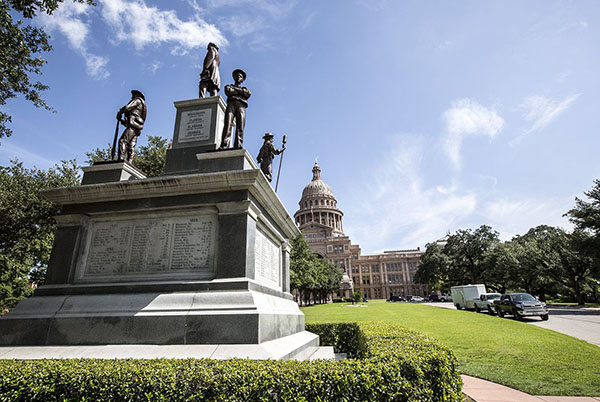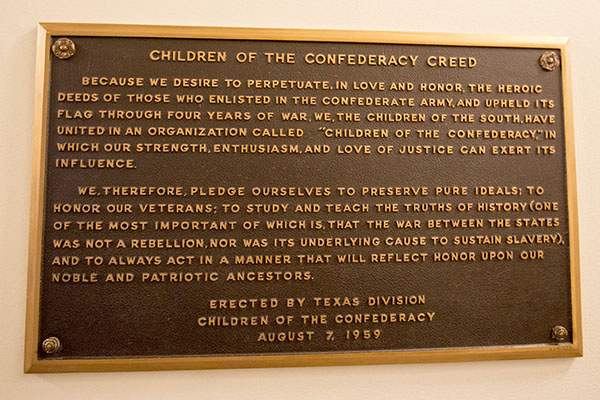| Communication & Memory |
 |
   |
| COM 75-444 | Spring 2023 |
Case Study on History/Cultural Memory: Central Texas Confederate Memorials/Monuments
| Communication & Memory |
 |
   |
| COM 75-444 | Spring 2023 |
Case Study on History/Cultural Memory: Central Texas Confederate Memorials/Monuments
There are a number of Confederate monuments or memorials close by to us in central Texas. Many of you will know about the one in front of the Williamson County Courthouse on the square in downtown Georgetown, and may even have participated in the many protests recently around the statue. President Trombley shared an essay about that statue with the campus community a while back, which I have linked here if you haven't already read it.
There are also a number of Confederate memorials and monuments inside and on the grounds of the Texas State Capitol. The two most controversial are the Confederate Soldiers Monument (AKA the Confederate Dead Monument or Memorial) which was built directly in front of the Capitol (on the South side) in 1903, as Jim Crow was becoming firmly established in Texas, and the Children of the Confederacy Creed plaque placed inside the Capitol (on the first floor) in 1959, at the height of the Civil Rights Movement and the coordinated "massive resistance" of White Southerners to federal desegregation.
The state continues to maintain the Confederate Soldier Memorial despite many years of protests aimed at removing the Confederate Soldiers Monument and others from State Capitol Grounds, particularly after national attention was brought to the issue after the events in Charlottesville, VA, in August 2017. In June 2019, the Confederate Soldiers Monument was vandalized, and then quickly restored. The controversy there continues.
Texas State Representative Eric Johnson (D-Dallas), who is Black, had lobbied since 2017 to have the Children of the Confederacy Creed plaque located in the hall outside his office door removed. In January, 2019, the Texas State Preservation Board agreed to remove the plaque.





As we have seen in our course materials so far, the historical record is unequivocal about the fact that the Confederate States of America was formed when slave-holding states refused to give up the economic and political power afforded them by chattel slavery. This is especially evident in the documents Confederate States wrote and officially ratified to explain why they were seceding from the United States.
As a pertinent example here, I have linked to the Texas Ordinance of Secession, 1861. It clearly shows that the "rights" being fought over were very specific: the rights of Southern Whites to own slaves in particular, and the rights of Southern Whites to maintain white supremacy over Blacks in general. But because it happened here in Texas, and was written just a generation after Texas founded its own Republic, the Texas document goes further than that, in ways that are worth re-reading at this moment when Texas lawmakers and other lawmakers around the country are demonizing what they call "Critical Race Theory."
Like other Confederate states, Texas claims to be the true carrier of the legacy of the American Revolution, and reiterates that white supremacy is written into the U.S. Constitution, especially in relation to the 3/5ths clause. But additionally, the Articles also claim that secession is continuous with the aims and spirit of the Texas Revolution, as well, linking everything together explicitly around white supremacy in ways that are rarely taught in Texas public schools today, and in ways that will become increasingly rare if the current laws limiting the teaching of this history in public school are allowed to stand.
Critical race theory is not the monster it is made out to be by people who attack it. It is simply the idea that white supremacy has been central to the history of the U.S., and that centrality has been built into American culture and institutions in ways that continue to sustain white supremacy over Blacks as well as all people of color. The version of American and Texas history reflected in the Articles of Secession lays it all out explicitly: this was a country originally built by and for settler-colonialist White men, one founded on coercing the labor of African Americans, and forcefully appropriating the land of American Indians and Mexicans.
We have been studying how many of the attempts by the South to memorialize the Civil War disavow slavery as a motivation for fighting the War, calling up instead the ideology of the Lost Cause to argue that the war was fought to preserve "rights" and resist the coercion of the North. The Confederate Soldiers Monument clearly disavows what we know from the historical documents produced leading up the Civil War. It even claims that Southern Whites are the ones who are victims of coercion and subjugation, totally ignoring their own roles in coercing and subjugating Blacks during slavery and throughout Jim Crow, when this structure was built. While many White Southerners reinforce the ideologies of the Lost Cause and "massive resistance" to emphasize states' rights vs. federal rights, then, and now in the age Black Lives Matter, the battle is fundamentally about either maintaining or dismantling a system that structurally sustains white supremacy.
For Further Reading:
Texas State Capitol and Confederate Memorials
KXAN on 2019 Confederate Memorial Vandalism
Austin American-Statesman on 2019 Confederate Memorial Vandalism
Children of Confederacy Creed Plaque Removed January 2019
The U.S. Constitution and Slavery
|
Design, Photography, and Text © 2023 by Bob Bednar
Department of Communication Studies
|